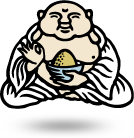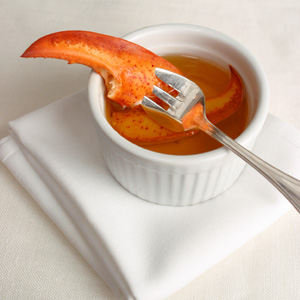Of Fat and Water
Posted by Pailin Chongchitnant on Friday, July 8th, 2011In browsing Herve This’ recipes, (please refer to this article for the history of why I am browsing through Herve This works) I found an interesting piece that is approachable and completely try-able at home, and I thought it would be of practical value to all. It’s an idea I have been interested in personally, and I have tried to utilize this concept in a few of my dishes. It is the idea of extracting from a piece of food fat-soluble flavor compounds and water-soluble ones in two stages in order to make sure I get every last bit of flavor that exists in that piece of food.
Here, Herve This applies it to the lobster. I have tried to do with Thai recipes, notably the Tom Yum Soup, where we normally simmer lemongrass, kaffir lime leaves, and galangal in water. I tried sautéing the herbs first before adding water, or even adding vodka to the soup to coax out any alcohol-soluble compounds out. I can’t say I found an astounding difference, but admittedly there were other confounding variables and I didn’t make two versions side by side, although it would be an interesting experiment to try. If you want to try to make a Tom Yum Soup at home using two techniques, please feel free and let me know how it goes. Here is my video recipe of the traditional recipe.
He also introduces to me the “kientzheim”, which sounds deathly delicious (and deathly to your arteries…) Another concept discussed is the emulsion of fat and water which he seems to revisit over and over again throughout this book using different fats and waters.
So here goes the translation:
Two Flavors From One
In making the lobster bisque, we classically brown the shells in oil, and then extract the aromatic compounds by simmering it in water. However, our chemistry knowledge tells us that the flavor compounds developed by this process are divided into two types: fat soluble and water soluble.
From this idea, we brown crushed lobster shells (so that we maximize the browning and thus miximize the development of aromatic compounds). Then we heat it, covered, slowly in some butter. This butter will then be whipped into a “Chantilly butter” or be made into a “keintzheim” (lobster butter keintzheim)
Then, the shells will be heated slowly in water, with some aromatic herbs, in order to extract the water soluble compounds, at which point we will have obtained two flavors derived from one.
The idea here is to serve the two parts together, and putting on one plate both the water flavor and fat flavor of the lobster.
Note 1: Chantilly butter is a method invented based on the crème Chantilly (whipped cream), which is an emulsion that we whip up. Here, we make an emulsion of butter and a flavored water, then we whip it on ice in order to obtain a consistency of whipped cream without the cream. We can easily imagine the lobster butter Chantilly on a grilled lobster.
Note 2: The kientzheim (named in honor of an Alsatian village of the same name) is a sauce made by the same method as a mayonnaise, except we replace oil with melted butter. So we can imagine a lobster butter kientzheim on a grilled lobster.



Posted on May 13th, 2013
Cornelius Hunn says:
Lemon oil may be used in aromatherapy. Researchers at The Ohio State University found that lemon oil aroma does not influence the human immune system, but may enhance mood.